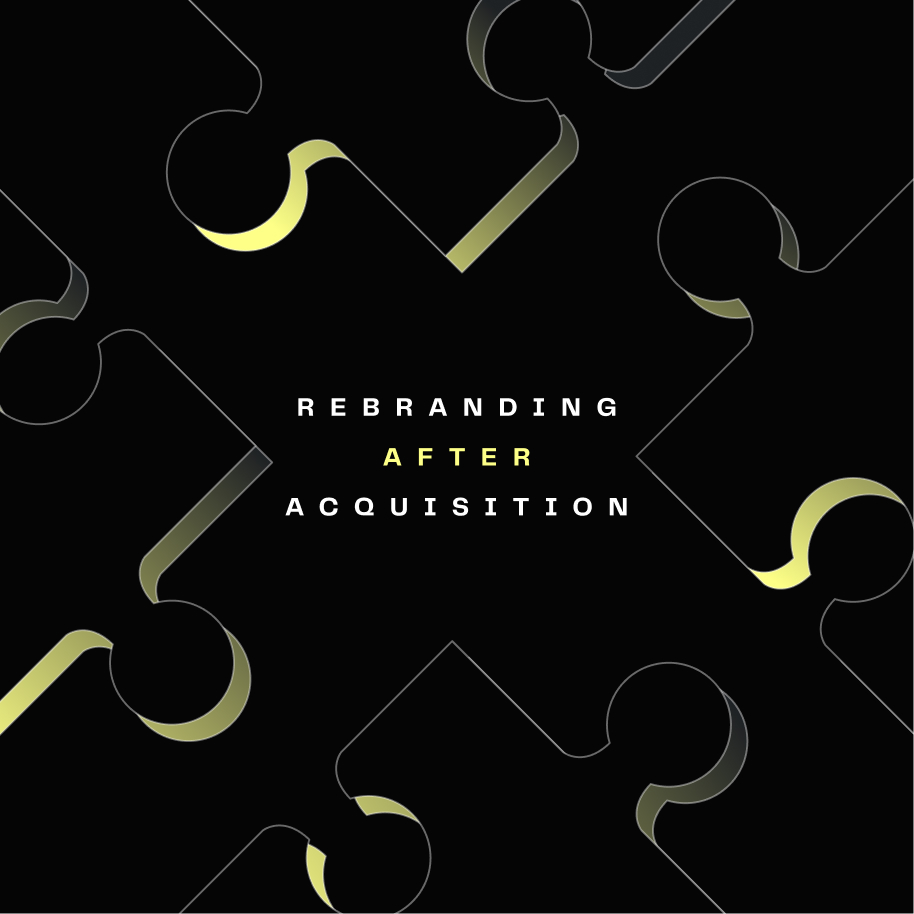If you’re reading this blog article, you may have acquired a company or perhaps you’ve been acquired. Congratulations! That’s certainly no small feat. But one of the most critical challenges lies in what happens after the papers are signed: acquisition branding, or integrating two distinct B2B brand identities into a cohesive whole.
Get the rebrand right, and you amplify the strategic value of your acquisition while preserving customer loyalty and employee engagement. Get it wrong, and you risk alienating stakeholders, confusing the market and undermining the very synergies that justified the deal in the first place.
Having guided dozens of organizations through post-acquisition rebrands, we’ve learned that success requires more than creative vision (though that’s also extremely important). It requires a solid strategy and sound planning.
With that in mind, here’s your roadmap for navigating the acquisition branding process.
Phase 1: The acquisition branding audit.
Before making any decisions about your brand direction, you need a comprehensive understanding of what you’re working with.
Start by quantifying the brand value of both organizations. This means conducting research with stakeholder groups to understand brand associations, trust levels and perceived differentiation. What does each brand represent in the market? Where do these brands have strong equity? And where are there gaps or negative associations?
Pay particular attention to brand recognition metrics in your core market segments. Sometimes the acquired brand may have stronger recognition in certain verticals or geographies than the acquiring brand. Having insight into this could fundamentally shift your rebranding strategy.
Examine how both brands are positioned relative to competitors. Do positioning conflicts exist between the two brands? What about complementary strengths? Understanding the competitive landscape will help you identify opportunities to create a stronger combined position than either brand held individually.
Catalog all digital properties, content libraries and marketing materials. This seemingly mundane task often reveals opportunities for consolidation and identifies high-value assets that should be preserved through the transition.
Phase 2: Legal and IP considerations.
The legal landscape of brand integration is fraught with potential pitfalls. Therefore, early engagement with legal counsel is essential.
Conduct a comprehensive review of all trademark registrations, domain names and intellectual property rights held by both organizations. This includes brand marks, product names, taglines and any proprietary terminology that’s become part of your brand vocabulary.
Review all contracts for brand usage requirements or restrictions. Partnership agreements, licensing deals and vendor contracts may contain specific brand guidelines that could impact your rebranding timeline or approach.
In regulated industries, brand changes may require approval from governing bodies. Factor these timelines into your project planning from the outset.
Identify potential legal risks associated with different integration approaches. Sometimes a gradual transition reduces risk compared to an immediate cutover, even if it’s more complex.
Phase 3: Stakeholder alignment in acquisition branding.
Perhaps no aspect of post-acquisition rebranding is more delicate than managing the human element. Brand identity is deeply personal. It represents years of hard work, cultural values and professional identity. Approaching this with empathy is crucial for success.
Begin with alignment sessions involving leadership from both organizations. What are the nonnegotiables for each team? What compromises are they willing to make?
Next, develop an internal communication plan that acknowledges the emotional aspects of brand change while clearly articulating the strategic rationale. Employees from the acquired company may feel that their brand identity — and by extension, their professional identity — is being erased. We know this isn’t the case. But it’s important to acknowledge that change is hard.
Consider creating employee advisory groups from both organizations to provide input throughout the process. This generates valuable insights while creating buy-in and advocates for the new brand direction.
Engage customers and partners in the brand development process through advisory sessions or research interviews. Their perspective on brand associations and preferences can provide insights that internal stakeholders might miss.
Phase 4: Defining your brand architecture.
With stakeholder input gathered and constraints understood, you can begin crafting your brand architecture; that is, the strategic framework that will guide all subsequent creative.
This is where acquisition branding strategy becomes concrete. Consider four primary brand architecture approaches:
- Master brand strategy: The acquired brand is fully absorbed into the parent brand. This approach maximizes brand consolidation benefits but may sacrifice acquired brand equity.
- Endorsed brand strategy: The acquired brand maintains its identity but is clearly connected to the parent brand (e.g., “Company X, a Division of Parent Corp.”). This preserves brand equity while signaling the relationship.
- Portfolio brand strategy: Both brands continue to operate independently under a parent umbrella. This approach is often used when brands serve different market segments.
- Hybrid strategy: Elements of the acquired brand are integrated into a refreshed parent brand, creating something new that honors both legacies.
Before finalizing your architecture decision, test leading options with stakeholder groups. This research investment pays dividends by identifying any potential issues before they become actual problems.
Phase 5: Creative development and brand expression.
This is the fun part. With your strategic foundation in place, you can begin the creative process of bringing your new brand architecture to life.
Whether you’re evolving a brand or creating something entirely new, ground your creative development in the insights from earlier phases. The most beautiful brand identity is worthless if it doesn’t resonate with your audiences or support your business objectives.
Create detailed brand guidelines that include visual identity as well as tone of voice, messaging frameworks and application principles. Also, make sure these guidelines are available where your team is likely to look for them. Brand guidelines that nobody consults might as well not exist.
Plan for the creation and adaptation of assets, sales materials and digital properties. This often represents a significant time investment, so prioritize based on business impact and customer-facing visibility. You might consider creating transition versions of key materials that can bridge from old to new brand expressions during the rollout period.
Phase 6: Internal and external change management.
If your team members aren’t on board with your acquisition branding strategy, your customers or clients may not be either. Start by bringing your team members along for the ride. Develop a training program that ensures every employee understands why your brand matters and how it connects to your business strategy.
This is particularly important for customer-facing teams who will be answering questions about the change. Develop FAQs and talking points that those teams can reference. Your customers may have questions following an acquisition and rebrand, so consistent, well-informed responses are crucial.
Craft an external communication strategy that proactively addresses customer concerns while highlighting the benefits of the brand change. Consider the timing of your external announcement carefully. You want to communicate changes before customers discover them but not so early that you can’t deliver on your promises.
It’s also important to establish feedback mechanisms that allow team members and customers to surface challenges or suggest improvements. Brand implementation may not be perfect from day one, and creating channels for continuous improvement demonstrates commitment to getting it right.
Establish metrics and monitoring systems to track the success of your rebrand. This should include both quantitative metrics (brand recognition, customer satisfaction, employee engagement) and qualitative feedback from stakeholder groups.
Plan for post-launch optimization. Even the most carefully planned rebrand will reveal opportunities for improvement once it’s live.
Phase infinity: Building on your new foundation.
The organizations that extract maximum value from their rebranding following an acquisition are those that view it as the beginning, not the end, of their journey. They use the aligned brand platform as a springboard for enhanced customer experiences, more effective sales processes and stronger market positioning.
Above all, they recognize that branding, even in B2B, is ultimately about people — the team members who bring your organization to life every day and the customers who choose to do business with you.
With methodical planning and a finger on the pulse of the people who make up your organization and its customer base, rebranding becomes an opportunity to create something greater than the sum of its parts. And that kind of strategic advantage is always worth the investment.
Ready to start your organization’s rebrand? Let’s talk.



